Fire accidents in workplaces are no longer unusual. About 140,000 non-residential blazes occurred in 2022, reports NFPA. That accounts for 9% of the blazes that occurred in 2022. An estimated 150 civilians died in those blazes, and about 1,400 civilians were injured. These infernos resulted in $4.0 billion in losses in direct property damage.
As an employer, it is your duty to protect your employees and the workplace from fires. Installing fire safety equipment can help you do so.
Here, we’ll discuss a few indispensable pieces of fire safety equipment that your workplace must have.
#1 Smoke Detectors
Early detection is the key to preventing fire-related disasters. Smoke detectors do a great job of alerting building occupants in the event of a blaze. Thus, they should be vital components of your workplace’s fire safety infrastructure.
Smoke detectors send out a loud beeping noise to alert people of a potential fire when they detect smoke. These devices also flash lights for people who are hard of hearing.
As per the general guidelines of the Occupational Safety and Health Administration (OSHA), you must install at least one smoke detector in each room, hallway, and storage area.
Consider installing them in strategic locations throughout your workplace, including elevators, stairwells, dumbwaiter shafts, and other enclosed spaces.
However, avoid installing smoke detectors in places where humidity is high. It is also a good idea to keep smoke detectors ten feet away from heat-producing appliances. These devices will trigger false alarms if you place them in such areas, resulting in chaos.
#2 Fire Extinguishers
Did you really plan for fire safety if your workplace lacks a fire extinguisher?
A fire extinguisher can prevent flames from turning into blazes by dousing them completely or containing them. It is, therefore, an indispensable item for fire safety in the workplace.
OSHA requires employers to provide firefighting equipment to their employees to protect them against blazes. Thus, it’s a must-have in the workplace. In fact, there should be an abundance of them in your establishment. However, choosing the right type is the key to preventing a fire outbreak.
Water-based extinguishers work well on Class A fires—flames involving flammable solids. ABC powder extinguishers are highly versatile, as they can douse Class A (solid combustibles), Class B (flammable liquids), and Class C (flammable gasses) fires. Wet chemical extinguishers have a Class F rating. That means they are ideal for extinguishing flames involving cooking oil.
AFFF fire extinguishers are highly effective in putting out Class A and Class B blazes. However, we advise you against it. That is because AFFF is linked with cancer. AFFF contains per- and polyfluoroalkyl substances (PFAS) that have been documented to cause cancer.
Studies on cancer risk among firefighters exposed to PFAS-containing AFFF demonstrate an elevated risk for colon, prostate, testicular, bladder, kidney, and thyroid cancers. Another study links PFAS in AFFF to testicular cancer.
These findings give credence to mounting AFFF lawsuits from civilian and military firefighters who claim that exposure to PFAS in firefighting foams made them sick. Plaintiffs in the AFFF lawsuit allege that manufacturers, despite knowing that PFAS in AFFF will increase firefighters’ risk of cancer, failed to warn them.
Human exposure to PFAS, TorHoerman Law notes, can also result in liver damage, increased cholesterol, fertility problems, and elevated risk of asthma and thyroid disease. Over a dozen manufacturers have been sued by firefighters. Some of them include Tyco Fire Products, 3M, DuPont, and Chemguard Inc.
In regard to the AFFF lawsuit update, 7,738 cases await consolidation. This number represents a significant increase from the previous month when there were only 7,170 lawsuits.
Instead of AFFF, go for fluorine-free extinguishers. These are highly effective in extinguishing Class A and Class B fires.
#3 Emergency Lighting
In the event of a blaze, visibility can quickly be compromised, leading to panic among occupants. A backup is, therefore, needed to ensure workers’ safety when infernos cause power outages. That is why you must consider installing emergency lighting in your workplace.
These lighting systems activate automatically when the main power supply fails, illuminating stairwells, escape routes, and other areas. Emergency lighting systems guide people toward escape routes and exits, reducing confusion and panic during emergencies.
Strategically placed emergency lighting enhances overall evacuation procedures, especially in large or complex buildings where visibility may be limited.
To sum things up, equipping your workplace with fire safety equipment is not just a legal obligation but a moral imperative. These equipment are a no trade-off in the workplace, irrespective of how small or large it is.
Besides, OSHA requires employers to provide proper exits and training to employees to prevent fire injuries and death in the workplace. Hence, teach your employees the right way to use fire extinguishers. Also, give them a written evacuation plan
, so they will know where to head in the event of a blaze.

